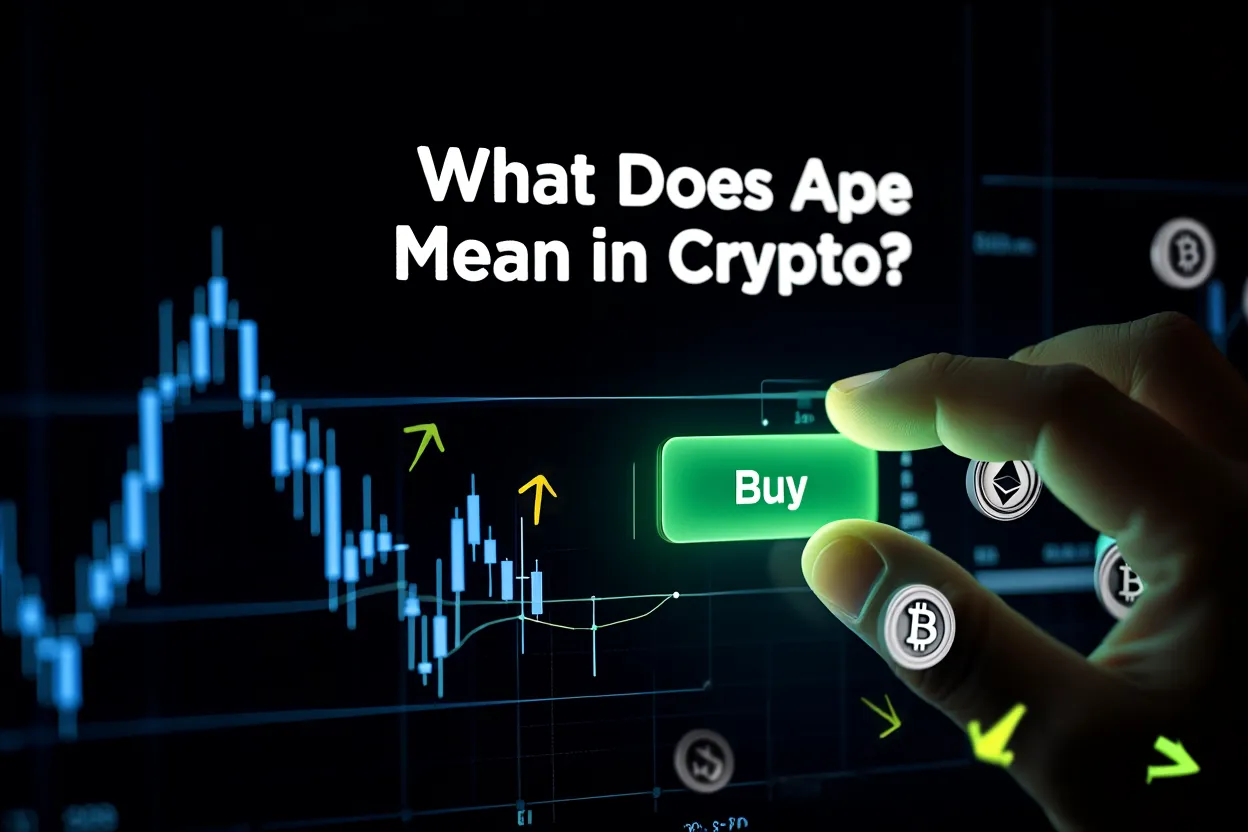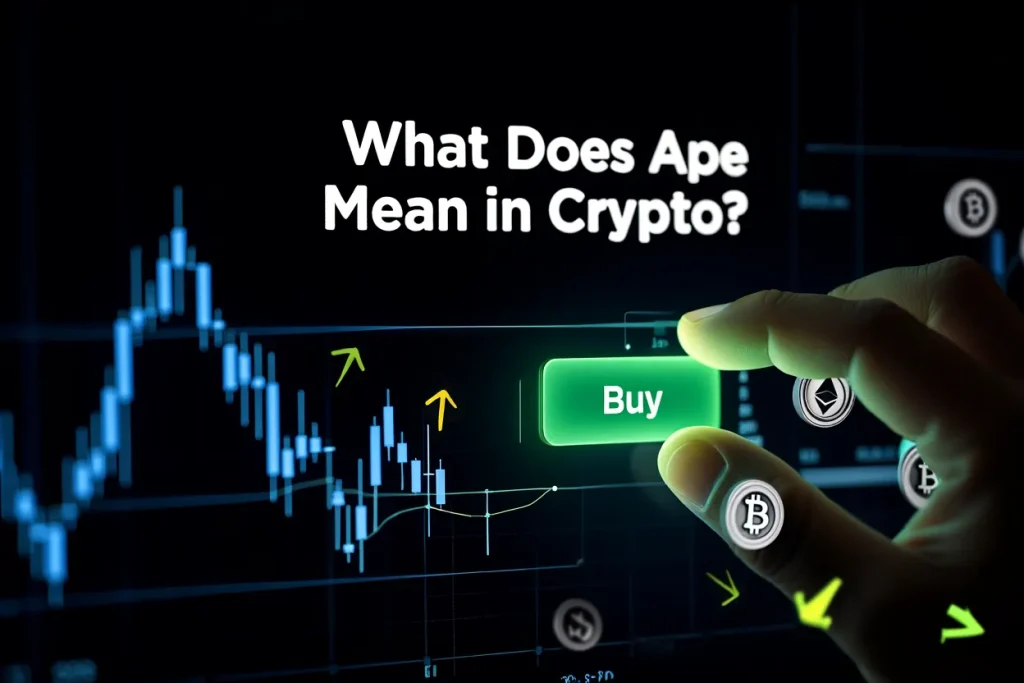Physical Address
304 North Cardinal St.
Dorchester Center, MA 02124
Physical Address
304 North Cardinal St.
Dorchester Center, MA 02124

In crypto communities, the term “ape” or “apeing” has become a staple phrase, often popping up in Discord channels, Telegram groups, and trending posts on Crypto Twitter. To ‘ape’ means to jump into a cryptocurrency or NFT project quickly, typically with minimal research, driven by hype or the fear of missing out (FOMO). As digital assets and new projects multiply, both newcomers and experienced investors encounter this term sometimes as encouragement, sometimes as a warning.
Article scope:
“Just aped into the latest Ethereum layer 2 launch. LFG!” is a phrase you might see on X in 2025, and this article aims to break down exactly what that means, why it matters, and how to navigate ‘apeing’ wisely as you explore the fast-evolving world of crypto trends.
In crypto speak, to “ape” or go “apeing” is to buy into a cryptocurrency, NFT, or DeFi project rapidly and often impulsively with little due diligence or research. Unlike strategic investment, it’s mostly driven by hype, viral buzz, or FOMO. Importantly, “apeing” is the investor’s behavior, not to be confused with tokens like ApeCoin (APE) which are specific assets.

For example, you might read: “Everyone’s talking about this presale I’m aping in now!”
Across social platforms, the tone behind “ape” usage swings between excitement and tongue-in-cheek warnings highlighting collective enthusiasm, the thrill of risk, or the dangers of reckless investing. It’s a shorthand for the communal, sometimes impulsive, energy in crypto markets.
The term “ape” draws from the broader English phrase “go ape,” meaning to act with wild enthusiasm or little restraint. In crypto, it gained traction during the DeFi summer of 2020, as traders rushed into new liquidity pools and yield farms on Ethereum without in-depth vetting. Forums like Reddit’s r/cryptocurrency and Crypto Twitter amplified the slang, with users posting memes and stories about “aping in” for the adrenaline and occasional profits.

Cultural references and meme history now closely tie “apeing” to risk-taking and market psychology in digital assets.
Originally a niche term, “apeing” is now both a meme and an investment strategy, shaping how entire communities interact with the latest tokens or NFTs. Relentless hype meant “ape” wasn’t just a mindset it became marketing for projects targeting rapid, viral adoption.
“Apeing” now signals both playful belonging and critical risk-taking in crypto markets.
The urge to “ape” into crypto is rooted deeply in investor psychology and it’s not just about quick profits. Social influence, viral FOMO, and digital tribalism all play significant roles. Here are the key motivators:
If “User X” spots a new memecoin surging on X (formerly Twitter), and sees their feed erupting with “Ape in before you miss it!”, their decision may be more emotional than rational even if it runs contrary to long-term investing principles.
These real-world scenarios translate the hype and excitement of apeing into tangible market moves and potential risks.

Warning: While apeing can deliver outsized wins for a lucky few, it exposes most to severe financial risk. Many who rush into crypto tokens or NFTs without due diligence face rapid losses and painful lessons.
Examples from reputable sources like Cointelegraph and Decrypt show that even seasoned traders can get caught in “apeing gone wrong” entire communities have lost millions in a matter of minutes when scams unraveled, or when volatile tokens crashed unexpectedly.
These cautionary examples make clear: apeing carries real, often immediate, consequences for the unwary.
While the energy around new crypto projects can be contagious, smart investors slow down and vet every decision. Compare these approaches:

| Smart Investor | Ape Investor |
|---|---|
| Researches project background, team, and use case (DYOR) | Buys based on viral buzz without research |
| Assesses risk tolerance and portfolio mix | Puts in more than they can afford to lose |
| Uses reputable sources and tools (e.g., CoinGecko, DeFi Llama) | Takes rumor and influencer shills at face value |
| Double-checks wallet security and contract details | Connects wallet to unknown dApps in haste |
| Skeptical of too-good-to-be-true promises | Chases “100x” hype blindly |
Key safety tips: Take time to verify, ask questions in community channels, and always use best-practice research portals. Never invest more than you’re willing to lose, and remember delayed gains are often safer than fast losses.
Related reads to deepen your knowledge:
| Term | Definition | Context/Relevance |
|---|---|---|
| FOMO | Fear of missing out | Core driver behind apeing behavior |
| HODL | Hold on for dear life (not selling through volatility) | Contrasts with impulsive apeing |
| DYOR | Do Your Own Research | Counterpoint to apeing, foundational advice |
| Degen | Degenerate gambler; someone who takes high risks | Often overlaps with ape investors |
| Rug Pull | Developer scam where project is abandoned suddenly | A primary risk for those who ape in |
| Moon | Slang for a token’s price skyrocketing | What many hope happens after apeing |
| Bagholder | Someone left holding worthless tokens after a crash | Common end situation for failed apes |
| Whale | Investor with a large holding able to move markets | Whale actions can trigger mass apeing |
Understanding these terms places “ape” in its broader semantic and cultural neighborhood, making it easier to spot hype and navigate tribal language in crypto spaces.
Definitional & Comparative FAQs
While viral anecdotes highlight lucky early apes profiting, the vast majority face losses. Success stories are rare exceptions, not the rule never ape in expecting guaranteed riches.
Apeing is impulsive and short-term, aiming for quick wins; HODLing is patient, focusing on long-term growth regardless of volatility. Many combine both, but HODLing is generally less risky.
If you’re an experienced trader with a defined loss limit, real-time data, and access to insider information, selective “apeing” (with strict controls) can yield profits otherwise, the risks typically outweigh the rewards.
Understanding “ape” in crypto is about more than slang it’s a window into the psychology, culture, and evolving strategies of digital asset investing in 2025. Apeing reflects both the allure and the danger of impulsive, hype-fueled decision-making, especially as new projects and trends multiply. Armed with knowledge of the risks, best practices, and related lingo, you can navigate crypto trends with greater clarity and confidence. Always remember: research beats rush, and staying informed is your best tool against the pitfalls of hype.
At Webtaichinh, our mission is to provide you with clear, unbiased insights into the world of cryptocurrency through the Cryptocurrency category, helping you navigate complex topics with confidence, without hype or hidden agendas.
Webtaichinh delivers real-time financial updates, ensuring you stay informed about market trends, policies, and global economic developments. As part of our commitment to excellence, we provide accurate information and in-depth analysis, empowering investors to make swift, confident decisions in a dynamic financial world.
For inquiries or personalized assistance, feel free to contact us:
📞 Phone: 055 937 9204
📧 Email: webtaichinh@gmail.com
💻 Website: https://webtaichinh.vn/
📍 Address: 13 Ho Tung Mau, An Binh, Di An, Binh Duong
At webtaichinh, your financial success is our mission.